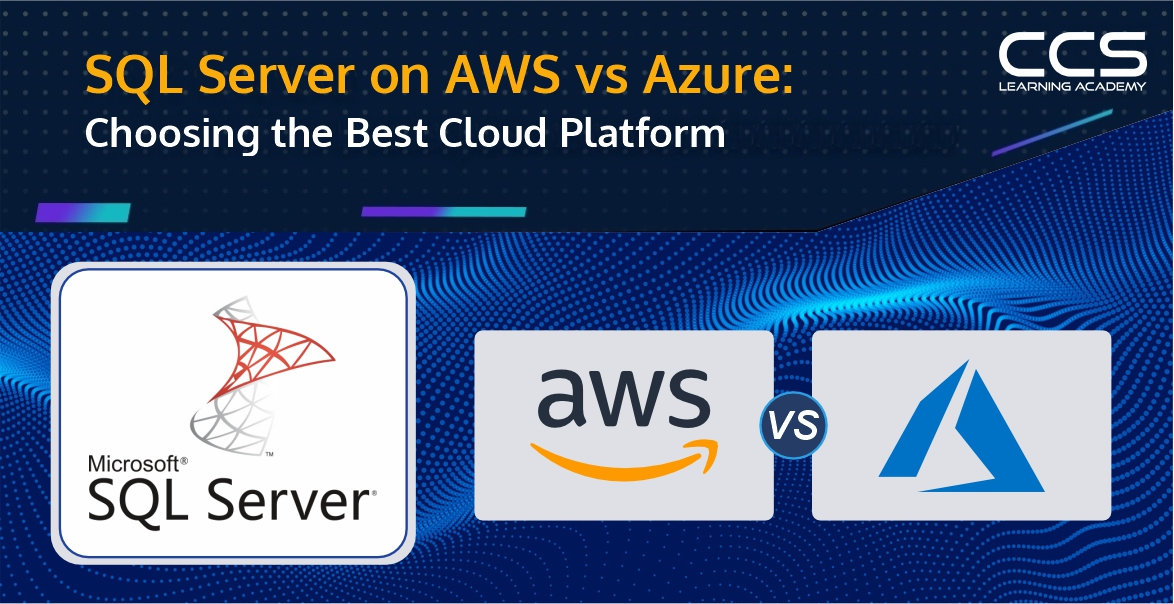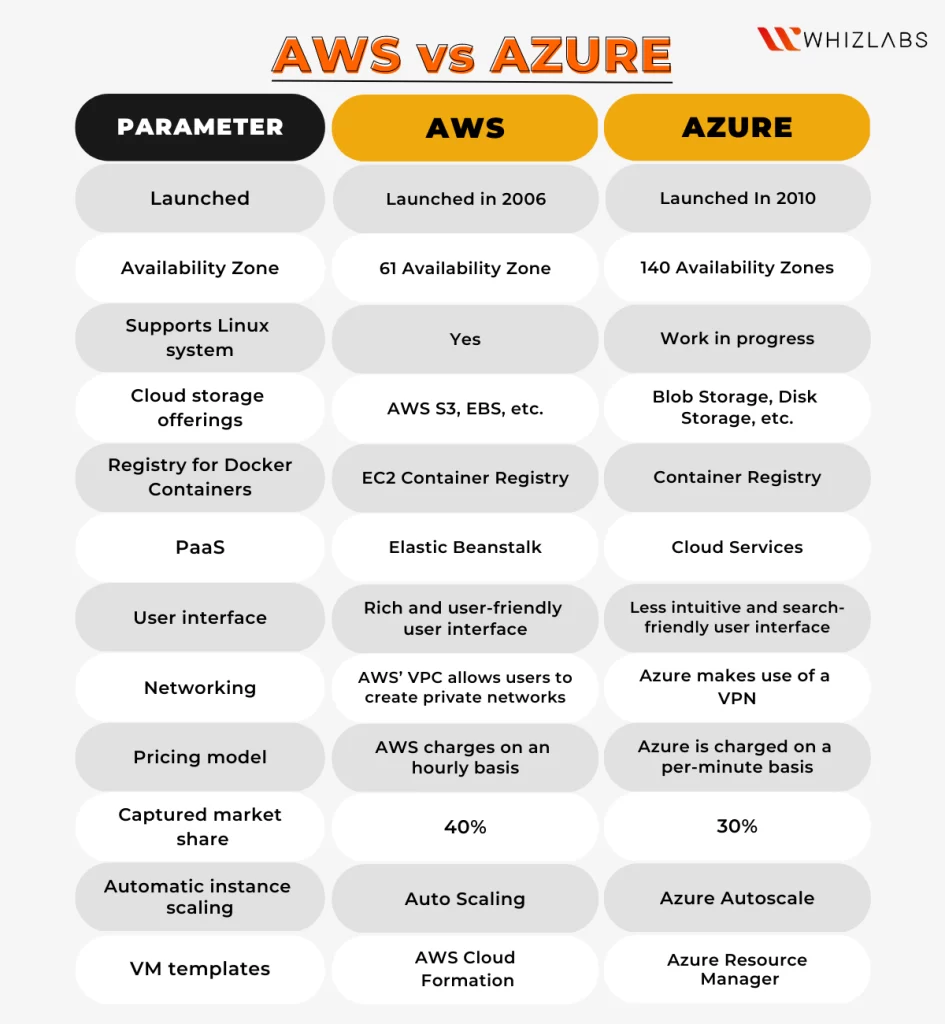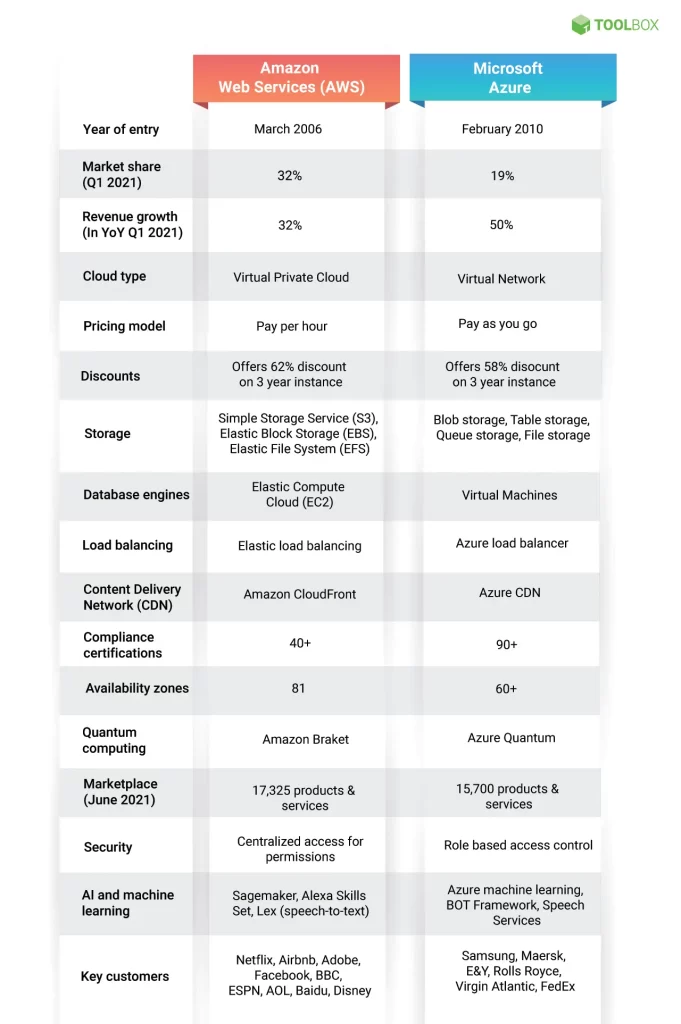SQL Server on AWS vs Azure: Choosing the Best Cloud Platform in 2025
- -
- Time -

As companies rapidly move their database workloads to public clouds, choosing between AWS and Azure for SQL Server deployments has become crucial. Both market leaders offer compelling options for running SQL Server in the cloud, making for a tough call.
When assessing the two dominant players, AWS holds an edge in terms of experience having been in the game over 15 years compared to Azure’s 13 years. However, Azure has narrowed the gap considerably and aggressively expanded its global footprint with availability in over 54 regions as opposed to AWS’ presence in over 25 geographical regions.
While AWS continues leading the market with around 31% share, Azure closely trails at 24% and together they account for over 55% of the worldwide cloud infrastructure spend. Both platforms extensively cover fundamental infrastructure and platform capabilities. Yet, each has certain differentiators.
This article delves deep into how each platform stacks SQL Server to help pick the right cloud partner for your needs.
Table of Contents
- AWS vs Azure
- Comparison of SQL Server Deployments on AWS and Azure
- SQL Server Deployments on AWS and Azure
- Managed Database Services
- SQL Server in Virtual Machines
- Disaster Recovery
- Tools and Integrations
- Performance and Scalability
- Pricing Considerations
- Multi-cloud or Hybrid Strategies
- Choosing the Right Cloud Platform: AWS vs Azure
- Conclusion
- FAQs
AWS vs Azure

Amazon Web Services (AWS) and Microsoft Azure are two dominant players in the cloud computing arena that have transformed how businesses and individuals access and leverage technology resources.
With its inception in 2006, AWS set out to address Amazon’s internal infrastructure needs but soon went on to establish itself as the foremost provider of on-demand cloud computing technology platform and application programming interfaces (APIs).
Azure, on the other hand, was officially launched in 2010 by Microsoft as a cloud service created, managed, and maintained for developing, testing, deploying, and running applications and services.
AWS originated from Amazon’s in-house technology infrastructure that was built over the years in silos by different teams, often duplicating efforts with no focus on efficiency. In a bid to optimize this hodge-podge setup, Amazon’s software engineers untangled the messy systems and replaced them with well-documented APIs. During a retreat in 2003, Amazon executives realized they had the wherewithal to effectively operate and scale data centers, giving birth to the commercial version of AWS.
Since its public introduction, AWS has grown from strength to strength, leveraging Amazon’s skills to provide scalable, dependable infrastructure solutions to companies and organizations of all sizes on an as-needed basis.
Unlike the evolutionary trajectory of AWS, Azure was conceptualized from the start as a cloud platform when it launched as Windows Azure in 2010. It was later rebranded as Microsoft Azure in 2014 to provide an elastic computing platform and associated services to enterprises through Microsoft-managed data centers.
Under the Azure umbrella, Microsoft offers virtual machines, app services, storage, database, analytics, AI, IoT, developer and other tools that work with a wide range of operating systems and programming languages. Azure stands out through its versatile scaling capabilities, letting businesses seamlessly ramp up or dial down service levels with a single click as infrastructure needs fluctuate.
Comparison of SQL Server Deployments on AWS and Azure
This table provides a clear overview of the advantages and unique features of SQL Server deployments on AWS and Azure, helping in making an informed decision between the two cloud platforms.
| Category | AWS (Amazon Web Services) | Azure (Microsoft Azure) |
|---|---|---|
| Infrastructure | EC2 instances, mature Windows-based VM hosting | Diverse VM sizes, native SQL Server integration |
| Managed Database Services | Amazon RDS for SQL Server | Azure SQL Database Managed Instance |
| Disaster Recovery | Cross-region replication, point-in-time restore | Geo-replication, automatic failover, integration with Azure Blob Storage |
| Tools & Integrations | CLI, AWS Console, Visual Studio, SSMS extensions | PowerShell, Azure CLI, Azure Portal, Visual Studio |
| Performance & Scalability | Optimized through EC2 hypervisors, automatic scaling | Microservices-based architecture, intelligent autoscaling |
| Pricing | Hourly billing, reserved instances, support fees | Pay-per-minute billing, hybrid benefits, low-priority VM discounts |
| Hybrid/Multi-cloud Strategies | AWS Outposts for on-prem extension, interoperability with Azure | Azure Arc for hybrid management, integrated tools for multi-cloud setups |
| Best For | Flexibility, vast service options, massive scale | Microsoft ecosystem integration, cost-efficiency, hybrid deployments |
SQL Server Deployments on AWS and Azure

SQL Server deployments on AWS and Azure offer database administrators various options to best suit their needs. Both cloud platforms provide infrastructure-as-a-service (IaaS) virtual machines (VMs) as well as platform-as-a-service (PaaS) managed database services for SQL Server. When weighing the benefits of each platform, several factors stand out.
AWS Lead in Windows-Based VMs
AWS has taken the lead in hosting Windows-based VMs with its mature EC2 compute service. EC2 offers a wide range of VM types to choose from based on specific workload requirements. This gives DBAs more flexibility to right-size their environments. With Azure following the Microsoft model of focusing initially on its Azure SQL Database PaaS option, AWS got a head start in hosting SQL Server VMs at scale.
Azure Catching Up with Competitive Options
However, Azure has since caught up and now provides competitive SQL Server VM options of its own. Where Azure gains ground is in its native integration with SQL Server. Migrating existing SQL Server databases to Azure VMs allows them to seamlessly plug into the Microsoft technology stack. DBAs benefit from familiar tooling and an easier learning curve compared to managing SQL Server on non-Microsoft infrastructure.
PaaS Database Services: AWS RDS vs Azure SQL Managed Instance
For PaaS database services, both AWS RDS and Azure SQL Managed Instance aim to take most of the administration burden off DBAs’ plates. This allows them to focus more on strategizing optimizations and scaling their databases. RDS supports various database engines while Azure SQL Managed Instance specifically supports SQL Server. When it comes to monitoring and performance management, Azure SQL MI has a slight edge with built-in AI features.
Azure’s Advantage with Hybrid Solutions
A key area where Azure pulls ahead is with its Azure Arc and Hybrid Benefit offerings. Azure Arc allows organizations to extend Azure management to on-prem and third-party environments. This bridges the gap between cloud and on-prem better than any other solution. The Hybrid Benefit further reduces licensing costs for existing SQL Server investments being leveraged in Azure. On the other hand, AWS RDS On-Premises extends RDS to Virtual Machines located on-premises or hosted externally.
Cost-Effectiveness and Value
In terms of cost-effectiveness, numerous studies have found both major cloud platforms provide good value for SQL Server workloads depending on specific use cases. Ultimately, while Azure has advantages for SQL Server-specific and hybrid scenarios, AWS remains the most full-featured option overall. It gives DBAs even more choices to right-size SQL Server deployments based on an organization’s unique needs and strategic alignment with either Microsoft or multi-cloud strategies. Both have a lot to offer, so thorough evaluation of each is needed before making a decision.
Managed Database Services
AWS and Azure each provide fully-managed database services for SQL Server. These services take off the operational burden of managing infrastructure, allowing DBAs to focus on the database layer.
Amazon RDS for SQL Server runs and scales SQL Server databases in the AWS cloud. It supports basic and high-availability configurations. RDS handles patching, backups, monitoring, and auto-scaling under the hood. However, customizing aspects like processor/memory configurations requires engaging AWS Support.
Azure SQL Database Managed Instance delivers a fully managed SQL Server experience on Azure. It picks up right where the on-premises SQL Server left off, with the same capabilities and interfaces while gaining scalability and disaster recovery benefits of the cloud. Setting up a Database Instance is a breeze with a simple point-and-click interface.
SQL Server in Virtual Machines
For more control or advanced setups, both clouds enable launching SQL Server in customized Virtual Machines (VMs).
AWS offers EC2 instances where you can provision Windows or Linux VMs and install SQL Server yourself. EC2 provides virtualization at scale but demands manual administration of OS, databases, security updates, backups etc. It suits complex multi-tenant applications or existing environments being migrated.
Likewise, Azure Virtual Machines allow deploying SQL Server in a customized virtual environment. A diverse set of VM sizes and disk types give flexibility to tune resources. Auto-patching keeps the guest OS updated. Backups are manual or can integrate Azure Backup for automated protection.
Database replication and high-availability patterns like Always On Availability Groups can be better implemented with VMs versus managed services due to customization abilities. However, they add more system management work versus a hands-off database service.
Disaster Recovery
Both platforms facilitate disaster recovery for SQL Server through cross-region replication.
AWS provides native multi-region support through database read replicas in different AWS Regions. Point-in-time restoration of databases can restore to any point within the backup retention period. Long-term archival is possible using AWS Storage services.
Azure replicates databases between regions using geo-replication. Automatic and planned failovers maintain operation continuity. Backup and restore functionality supports point-in-time recovery. For long-term retention, integrated Azure Blob storage preserves database backups indefinitely.
Tools and Integrations
Management tools on the two clouds vary in breadth and maturity.
AWS offers robust command-line and GUI interfaces like CLI, and AWS Console to perform essential tasks. Visual Studio and SSMS extensions help with common development activities. A rich partner ecosystem supplements cloud capabilities.
Azure management tools focus on .NET developers. PowerShell, CLI and Portal equivalents of AWS offerings carry out database and VM actions. Visual Studio and SSMS plugins aid development and administration processes end-to-end on Azure. Well-integrated services and workflows make tasks seamless.
Performance and Scalability
All public clouds achieve performance levels sufficient for many database workloads. Factors like IOPS, throughput, memory and CPU available, network quality, and instance types influence database performance relative to dedicated hardware.
AWS’s EC2 virtualization hypervisors optimize resource usage through statistical multiplexing. Over decades of operation, AWS infrastructure delivers stable and consistent database performance tuned for scalability. Database services scale automatically based on load.
Azure adopts a microservices-based architecture designed for scale and resilience. It offers intelligent autoscaling to dynamically add/remove resources according to workload changes. Azure SQL Database’s elastic pools help sharing resources at scale without manual sharding or resource management.
Pricing Considerations
Both clouds price database services based on compute, storage and I/O consumption. However, pricing models differ per service and region.
AWS charges hourly for RDS and provisions storage separately. Reserved Instances bring significant discounts for long-term commitments. Support packages incur annual or monthly fees. On-demand EC2 is billed by the second with inexpensive reserved options.
Azure SQL Database and SQL Server VMs bill monthly. Hybrid Benefit transfers on-prem SQL Server licenses to Azure. SQL Instances reserve power proportional to instance size without additional memory charges. Storage attached to VMs adds to billing.
Multi-cloud or Hybrid Strategies
As complexity rises with growing cloud footprints, many companies adopt multi-cloud or hybrid strategies.
Azure Arc enables extending Azure management, monitoring and updates to any infrastructure including AWS and on-premises. It brings hybrid consistency and provides self-managed infrastructure options on AWS using familiar Azure tools and processes.
AWS Outposts deploys rack-scale infrastructure on customer premises as an extension of AWS regions while still using native AWS services and technologies. It facilitates workload portability across on-prem and cloud environments in a hybrid deployment.
AWS and Azure provide interoperability between their services to help customers establish hybrid and multi-cloud architectures more easily. Cross-cloud migrations are feasible due to similar database technologies and services used across vendors.
Choosing the Right Cloud Platform: AWS vs Azure
When venturing into the cloud, businesses must carefully consider their specific needs and choose the cloud platform that best aligns with those needs. While AWS and Azure all provide excellent cloud services, each platform has its own strengths that make it a superior choice for certain situations over the others. Letting one’s requirements drive the decision is key to getting the most value from their cloud investment.
AWS: The Cloud Giant
AWS has stepped up its cloud game for many years now, leveraging Amazon’s massive infrastructure and experience to build out a cloud empire. With over 200 fully-featured services on tap, AWS gives businesses the broadest set of tools to work with. Legacy applications built on MariaDB, MySQL, Oracle, PostgreSQL or SQL Server databases can all breathe easy on AWS thanks to robust managed database offerings like RDS. Those seeking a more modern database can check out high-performing Aurora. AWS’s extensive ecosystem means issues can generally be ironed out with robust community support as well.
However, AWS’s very mature and full-bodied service portfolio can be overwhelming for new cloud adopters or those with simple needs. Its pay-as-you-go model also means costs can pile up quickly if one isn’t diligent about optimizing resources. While AWS offers great scalability and flexibility, these come at a higher price tag compared to alternatives. For smaller firms just getting their feet wet in cloud computing, AWS’s sprawling service array and complex pricing may weigh it down.
Azure: The Microsoft Ecosystem
Stepping into Azure feels like very familiar ground for existing Microsoft shops. As the daddy of SQL Server, Azure makes transitioning those databases to the cloud a total breeze. Migrating over is streamlined with features like Azure SQL Database and SQL Managed Instance that keep things working exactly the same. What’s more, hybrid deployment options give Azure an edge for companies with applications straddling on-prem and cloud. Its broad tooling integration and tight ties to the rest of the MS stack create a very cohesive experience for Windows-centric devs and admins.
Cost efficiency is also a big win for Azure. Its pay-per-minute billing, monthly subscription commitments, and low-priority VM discounts and free tiers make sticking to a budget much simpler compared to AWS’s hourly billing model. For smaller deployments, in particular, Azure easily undercuts AWS on cost. However, over-reliance on proprietary Microsoft technologies could be risky if one’s business needs change dramatically in the future.
To recap, here are some guidelines on when each major cloud platform may be the right choice:
- AWS for massive scale, flexibility, and vast service options (higher initial cost but large ecosystems help optimize spend)
- Azure if heavily invested in Microsoft/Windows stack needs hybrid solutions or simple/predictable budgets
The sweet spot will depend entirely on individual business and technical factors. However, carefully aligning cloud requirements with platform strengths delivers transformative results every time. Choose wisely!
Conclusion
Both AWS and Azure have evolved into capable platforms for SQL Server deployments, each with their own strengths. Choosing one depends on aspects like existing skills, workload requirements, cost considerations, and long-term cloud strategies. A hybrid approach combining services from multiple clouds can also deliver the best of both worlds. Ultimately, picking the cloud that aligns with business objectives and technical needs the most will ensure a smooth SQL Server migration to the public cloud.
CCS Learning Academy offers a comprehensive curriculum that covers all aspects of Azure DevOps, ensuring that you gain in-depth knowledge and proficiency in this powerful platform. Our courses are meticulously designed to provide you with a solid foundation, covering everything from the basics to advanced concepts.
Additionally, our courses include practical projects that simulate real-world scenarios, providing you with hands-on experience. These projects allow you to apply what you have learned in a controlled environment, giving you the confidence and expertise to handle similar situations in your professional life.
Enrolling in our Azure DevOps courses equips you with the knowledge and skills to leverage this powerful platform, significantly enhancing your value in the software development industry. With a comprehensive curriculum, industry-relevant skills, hands-on experience, and flexible learning options, CCS Learning Academy is the ideal choice for anyone looking to advance their career in Azure DevOps.
FAQs
AWS supports SQL Server through its Relational Database Service (RDS) and on EC2 Instances, where users can manage their own SQL Server installations. Azure offers SQL Server as part of its Azure SQL Database service, a platform as a service (PaaS) solution, and on Virtual Machines (VMs) for a more customizable environment similar to EC2.
Both AWS and Azure offer “License Included” and “Bring Your Own License” (BYOL) options for SQL Server. AWS’s License Included option is available under the RDS model, whereas Azure offers it with SQL Database and SQL Server on Azure VMs. BYOL allows customers to use their existing SQL Server licenses with both AWS and Azure, provided they comply with the Microsoft License Mobility terms.
The performance can depend significantly on the specific configuration and use case. Azure generally provides highly optimized and integrated services for SQL Server, especially in the PaaS offerings like Azure SQL Database. AWS also offers robust performance, particularly with the flexibility and control available in EC2, which can be fine-tuned for demanding SQL Server workloads.
AWS offers various disaster recovery options for SQL Server, including automated backups, multi-AZ deployments for RDS, and the ability to replicate data across regions. Azure provides similar features with automated SQL backups, active geo-replication, and zone-redundant databases in Azure SQL Database, as well as geo-redundant storage in Azure VMs.
Both platforms offer robust security features for SQL Server. AWS provides security measures such as network isolation using Amazon VPC, and encryption at rest using keys you create and control through AWS Key Management Service. Azure similarly offers a Virtual Network, encryption with Azure Key Vault, and advanced threat protection capabilities.
AWS allows scalability with RDS and EC2, where you can scale compute and storage resources independently. Azure also allows for dynamic scalability, especially with SQL Database, offering scalable services with automated performance tuning and scalability without downtime.
The cost-effectiveness of hosting SQL Server can vary based on the instance types, the region, and specific feature requirements. Azure may offer better cost efficiency for organizations already invested in the Microsoft ecosystem. In contrast, AWS can be cost-effective with a more extensive range of options and potentially lower prices for certain configurations.
Both AWS and Azure provide tools and services to facilitate the migration of SQL Server databases to their cloud. AWS offers the Database Migration Service, and Azure has the Azure Database Migration Service, both designed to streamline the process of migrating from on-premises or other cloud services.
AWS and Azure both offer comprehensive support plans that include 24/7 access to support engineers, guidance on best practices, and assistance with troubleshooting. Support plans can be scaled and customized depending on the business needs and the criticality of the SQL Server deployments.
Choosing between AWS and Azure for SQL Server hosting should be based on several factors: existing infrastructure, specific SQL Server version requirements, integration with other services, pricing, and specific features like performance, scalability, and security. Consider which platform aligns best with your organizational needs and future growth plans.






